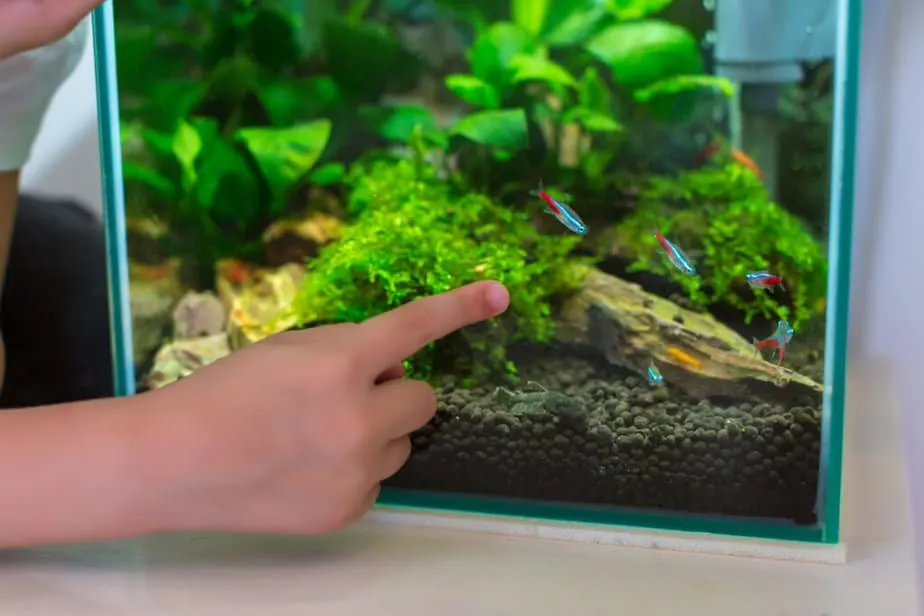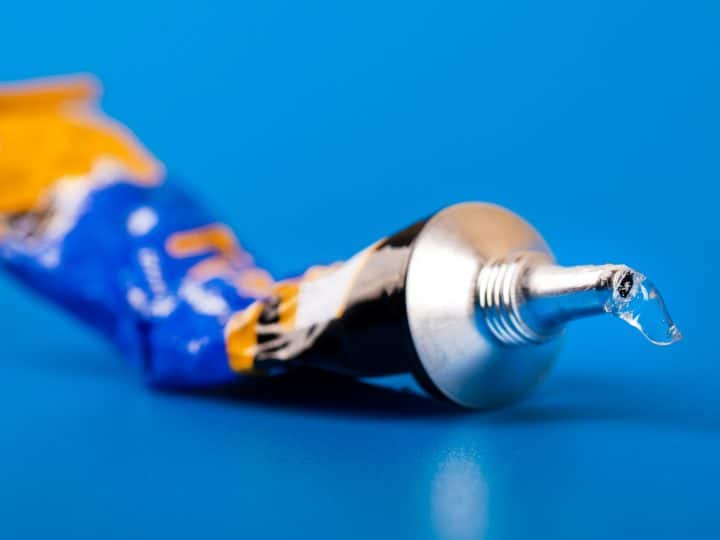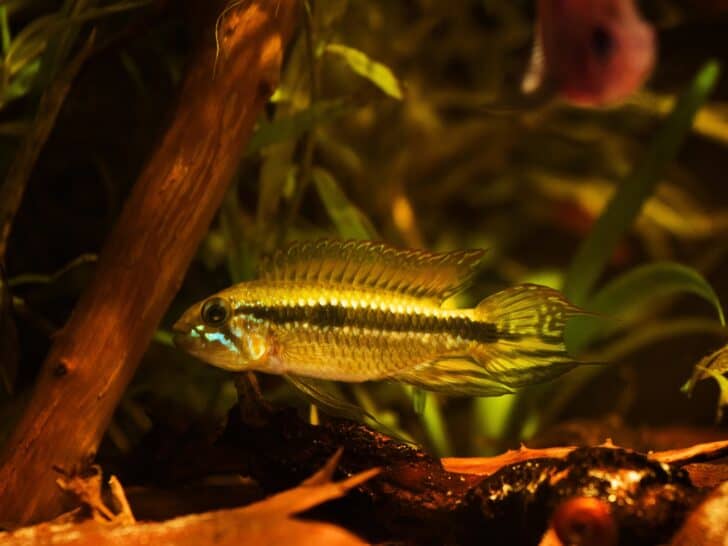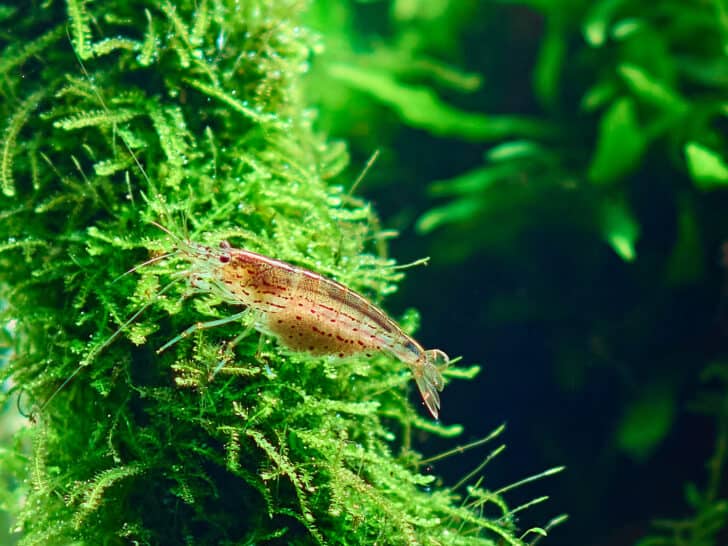To set up a miniature planted tank, first choose your aquarium, pick a good location, pick the right plants, clean the plants, add substrate into the tank, insert aquarium equipment, add some water, plant the plants, add some more water, add the lights, and give the plants some nutrients.
How to Make a Small Planted Aquarium: Step-by-Step
If you follow the 12 steps as I’ve listed below, you should have no problems setting up a small planted aquarium in a single day.
1. Choose Your Aquarium
First, you have to choose the aquarium itself. Here we are talking about a small aquarium, which I would say is anything under 10 gallons or 15 gallons at the most.
Although, you can also set up a nano planted aquarium, which is generally under 5 gallons in size. One of the most important choices for you to make here is between acrylic and glass aquariums. I definitely recommend doing some research on this front.
2. Pick the Right Location
Before you start thinking about plants, you need to pick up the location for the fish tank. Of course, it needs to be near an electrical outlet and water sources to make life easier.
However, so you can avoid temperature swings and algae growth, you don’t want to place the aquarium directly near areas of heavy air flow, near air conditioning vents, or right in direct sunlight. Also try not to put the fish tank in heavy traffic areas.
3. Pick the Right Plants
Another one of your biggest challenges here is going to be choosing the right kinds of plants. I personally have a few favorite types of plants that are ideal for small aquariums.

These include ones such as the anubias nana petite, cryptocoryne parva, dwarf hairgrass, bucephalandra, Christmas moss, monte carlo, staurogyne repens, echinodorus Vesuvius, moss balls, and java moss. There are plenty of other plants that stay small, but these are my favorites.
4. Rinse the Aquarium and Plants
Before you put anything in the tank, to ensure that the plants are free of debris and contaminants, sterilizing them first is recommended. By sterilizing, we just mean dipping them in a solution of diluted bleach.
A heavily diluted bleach solution for about 5 minutes should be more than enough to kill off any unwanted parasites and invaders, so you don’t end up introducing any of these things into your tank unwillingly. Just make sure to thoroughly rinse off the plants afterwards, or else you’ll also be introducing bleach into the tank.
Ideally, you also want to do the same thing for any decorations and hardscaping items that you are introducing to the tank. Anything and everything that can be washed, sterilized, and scrubbed before being put in the tank should undergo this process.
5. Add Your Substrate
When it comes to planted tanks, one of the most important components is the substrate. There are virtually no plants that can grow without a substrate of some kind. There are some options you have at your disposal here including aquarium gravel, aquarium sand, and even aquarium soil.
There are also small plants that you can tie right to driftwood or to rocks, and don’t really require a substrate.
Therefore, I recommend doing a bit of research into the different types of aquarium plants, the different types of substrates, and which ones are compatible with each other. Whatever the case, you’ll need at least two or three inches of an adequate substrate to get started here.
6. Insert Equipment and Hardscape Items
Once you’ve inserted a couple inches of substrate into your aquarium, it’s time to add all of your hardscape items, decorations, and things like aquarium filters and air stones. When you are doing this, make sure that you take the time to plan everything out, so you have plenty of room for your plants.
The driftwood and rocks are going to form kind of a framework of your plant tank, and your plants will go around and on top of these things. Therefore, take a good deal of time to plan this out, because you don’t want to start putting plants in the tank only to realize you don’t have enough space for the plants you’ve chosen.
On that note, you will also need an aquarium filter, especially if you plan on adding fish into the tank. Decaying plant matter and uneaten fish food will release ammonia and other unwanted substances into the water that can end up being harmful to both plants and fish. You absolutely need a decent filtration unit.
7. Add Water Into the Tank
Now it’s time to fill the tank about halfway with water, and make sure that it’s been dechlorinated. This means that you can either use a water conditioner or leave the water sitting out in the open for about a full day. In no case do you want to use fresh tap water. You have to let it sit for at least a full day. There is also the option of using reverse osmosis or distilled water.
8. Plant Your Plants
With everything required for the survival of your plants and fish inserted into the tank, it’s time to actually plant the plants. Important to note is that different plants require different planting techniques, so you want to do some research into the specific plants you have.
As for positioning, always make sure to place the tallest of plants in the back of the aquarium and the shortest plants in the front. If you put the tallest plants in the front, they’ll obscure everything else from sight. Also, make sure that plants that require a lot of light are placed in areas where they will get it.
9. Add More Water
With your plants planted in the substrate or tied down to anchors, it’s time to fill up the rest of the tank, and very gently. Just like you had to dechlorinate the water before step #7, you should also be adding dechlorinated water here.
Just make sure that you are extremely gentle when adding more water into the tank because you don’t want to cause any damage to your plants that were freshly planted.
Remember, plants that you have just uprooted and replanted in a different location are going to be fairly fragile and already stressed out due to being moved, so you don’t want to do anything to provide them with additional stress.
10. Add Lights
No matter the size of the tank, if you expect your plants to survive, they’ll need some light, and this needs to mimic natural sunlight. Therefore, I recommend getting either a hood with a built-in aquarium light or a separate aquarium light.
This doesn’t have to be anything super powerful, expensive, or overly special, but just enough to provide your plants with some natural sunlight. Remember, plants require natural sunlight to perform photosynthesis, and without this they cannot survive.
11. Provide Your Plants with Nutrients
If your tank is just starting out, you’ll need to provide them with some fertilizer. Some basic aquarium plant fertilizer does just fine, but always be sure to follow the directions on the labels, because too much can also be a bad thing. Some plants may also need some additional CO2, so make sure to provide this to your plants if they need it.
12. Add Fish
If you just want a planted tank, you can leave it at that, but many people want to add fish to the mix, in which case now is the time to do so. Just make sure that the fish you get are compatible with the small tank you have, and compatible with the plants in your aquarium.
Conclusion
As you can see, creating a small planted tank with small plants is not very difficult. As long as you follow the simple steps as listed above, it should all be very easy and quick.



